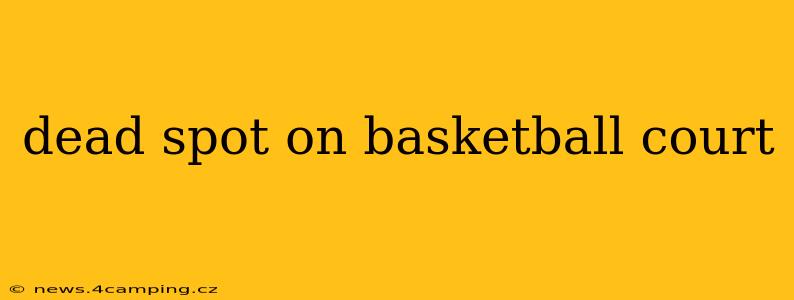Basketball is a game of precision and flow, but sometimes the ball just doesn't cooperate. This is often due to what players refer to as "dead spots" on the court. These areas, often unpredictable, can lead to frustrating bounces, unpredictable shots, and a general disruption to the rhythm of the game. Understanding these dead spots, their causes, and how to mitigate their impact is crucial for players of all levels.
What is a Dead Spot on a Basketball Court?
A dead spot on a basketball court is an area where the ball's bounce is inconsistent or unpredictable. This means the ball might not bounce as high as expected, might take an unusual trajectory, or might even seem to stick to the floor for a moment. These inconsistencies can drastically affect shots, passes, and dribbling, making it harder to execute plays effectively. They're more than just slightly uneven areas; they represent a noticeable deviation from the expected bounce of a properly maintained court.
What Causes Dead Spots?
Several factors contribute to the creation of dead spots on a basketball court:
-
Poor Court Maintenance: This is the most common culprit. Lack of regular sweeping, cleaning, and resurfacing can lead to the accumulation of debris, dust, and dirt, creating areas where the ball doesn't bounce consistently. Compacted areas where the surface has been worn down also create dead spots.
-
Improper Court Construction: If the court wasn't constructed properly in the first place, or if materials weren't of high quality, it might have inherent inconsistencies that lead to dead spots. This is especially true if the sub-base wasn't prepared correctly before the final surface was laid.
-
Wear and Tear: High-traffic areas of the court, such as directly under the basket or along the free-throw line, are more prone to wear and tear, leading to compaction and uneven surfaces. Over time, these areas can develop dead spots.
-
Weather Conditions: Extreme temperature fluctuations and excessive moisture can affect the court's surface, causing it to expand and contract unevenly. This can lead to small cracks and areas where the bounce is inconsistent.
-
Type of Flooring: Even with proper maintenance, different types of basketball court flooring have varying degrees of bounce consistency. Older courts or those made with less advanced materials are more susceptible to dead spots.
How Can I Identify Dead Spots?
Identifying dead spots takes practice and keen observation:
-
Pay Attention to the Ball's Bounce: If the ball's bounce seems consistently different in a particular area, it could be a dead spot. Notice if the ball bounces lower, higher, or at an unusual angle.
-
Observe Other Players: Do other players seem to struggle in a certain area? This could indicate a consistent problem.
-
Look for Visual Cues: Sometimes, you can visually detect areas of compaction or discoloration that might correlate with dead spots.
-
Experiment with the Bounce: Deliberately bounce the ball in different areas of the court to test for inconsistencies.
How to Deal with Dead Spots on a Basketball Court?
Dealing with dead spots depends on the cause and severity.
-
For Minor Issues: Simply adjusting your shot or pass slightly might be enough to compensate for a small, localized dead spot.
-
For More Significant Issues: Reporting the issue to the court's maintenance staff is crucial. They can assess the situation and perform the necessary repairs or resurfacing.
-
Practice Adaptation: Learning to adapt your game to deal with inconsistencies on the court is a valuable skill for any basketball player. Practice shooting and dribbling in areas you've identified as problematic to improve your consistency and confidence.
Can I fix a dead spot myself?
No, attempting to fix a dead spot yourself is generally not recommended. This often requires specialized equipment and expertise to ensure the repair is done correctly and doesn't cause further damage to the court surface.
What type of flooring is least likely to have dead spots?
Modern, high-quality synthetic surfaces, designed specifically for basketball, are typically more consistent and less prone to developing dead spots than older or less durable materials.
How often should basketball courts be resurfaced?
The frequency of resurfacing depends on several factors, including usage, weather conditions, and the type of flooring. However, a general guideline would suggest resurfacing every 5-10 years for heavily used courts.
By understanding the causes and characteristics of dead spots, and by being proactive in addressing them, you can significantly improve the playability of your basketball court and enhance your overall game. Remember, consistent practice and adaptation are key to overcoming any challenge the court presents.
